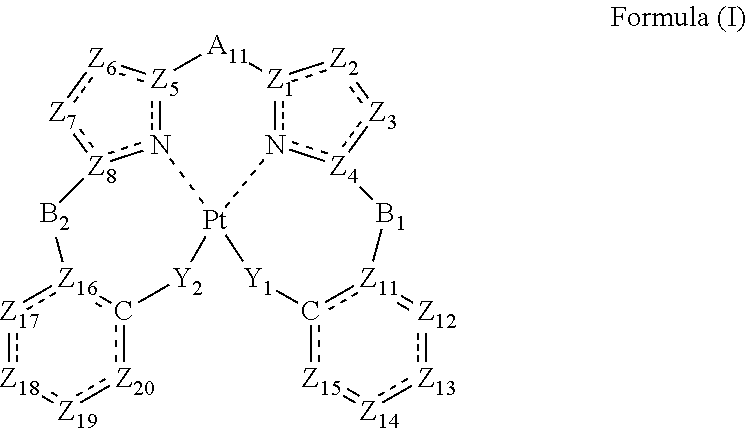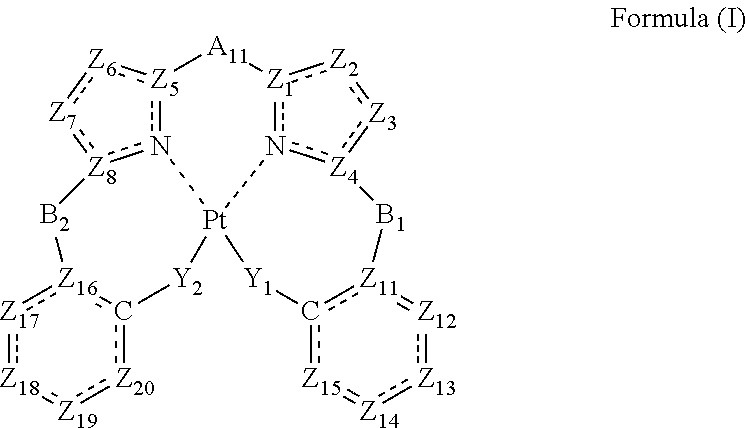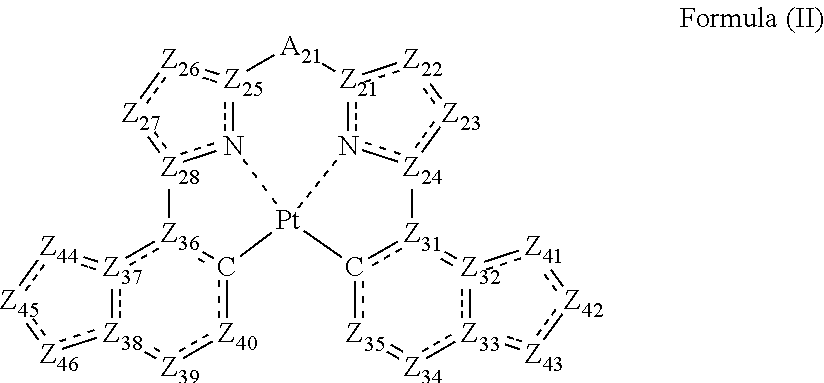Organic electroluminescence device
a technology of electroluminescence device and complex compound, which is applied in the direction of luminescent composition, organic chemistry, platinum organic compounds, etc., can solve the problems of insufficient devices, insufficient luminescence quantum efficiency, and inability to meet the requirements of high efficiency and high durability, and achieve good light emission properties (emission wavelength, luminance, quantum yield, driving voltage) and durability.
- Summary
- Abstract
- Description
- Claims
- Application Information
AI Technical Summary
Benefits of technology
Problems solved by technology
Method used
Image
Examples
example 1
[0244]In a similar manner to Comparative Example 1 except for the use of Compound (31) of the invention (emission wavelength: 480 nm) instead of Comparative compound 1, an organic EL device of Example 1 is fabricated. When a DC constant voltage (7V) is applied to the organic EL device thus fabricated, bluish green light emission is observed. At the same luminance, the voltage of the organic EL device of Example 1 is 0.95 time of that of Comparative Example 1, 0.9 time of that of Comparative Example 2, and 0.89 time of that of Comparative Example 3. The external quantum efficiency of the organic EL device of Example 1 is 1.2 times of that of Comparative Example 1, 1.5 times of that of Comparative Example 2, and 1.2 times of that of Comparative Example 3. The luminance half-life of each of the organic electroluminescence devices thus obtained is determined by setting the device in “OLED Test System Model ST-D” manufactured by Tokyo Systems Development and driving it in a constant curr...
example 2
[0245]In a similar manner to Comparative Example 1 except for the use of Compound (20) of the invention (emission wavelength: 445 nm) instead of Comparative Compound 1, an organic EL device of Example 2 is fabricated. When a DC constant voltage (7V) is applied to the organic EL device thus fabricated, blue light emission is observed. At the same luminance, the voltage of the organic EL device of Example 1 is 0.95 time that of Comparative Example 1, 0.9 time of that of Comparative Example 2, and 0.89 time of that of Comparative Example 3. The external quantum efficiency of the organic EL device of Example 2 is 1.1 times that of Comparative Example 1, 1.4 times that of Comparative Example 2 and 1.2 times of that of Comparative Example 3. The luminance half-life of the organic electroluminescence device thus obtained is determined by setting the device in “OLED Test System Model ST-D” manufactured by Tokyo Systems Development and driving it in a constant current mode under the conditio...
examples 3 to 18
[0247]Organic EL devices of Examples 3 to 18 are fabricated in a similar manner to Comparative Example 1, except that Comparative compound (1) is replaced by the present compounds listed in the following Table 1, respectively. On the organic EL devices of Examples 3 to 18, evaluations of a driving voltage, an external quantum efficiency and a luminance half-life in the case of driving under a forward constant current of 0.4 mA are made under the same luminance condition, and data obtained by measuring their individual evaluation results against Comparative Examples 1, 2 and 3 are summarized in Table 1, Table 2 and Table 3, respectively (, wherein individual items of data are shown as relative values, with those of Comparative Examples 1, 2 and 3 each being taken as 1).
TABLE 1Relative values based on the data obtained in Comparative Example 1ExternalDrivingquantumLuminanceExample No.Light emitting materialvoltageefficiencyhalf-lifeExample 3Compound (1) of the0.981.11.1inventionExampl...
PUM
| Property | Measurement | Unit |
|---|---|---|
| temperature | aaaaa | aaaaa |
| water absorption | aaaaa | aaaaa |
| water absorption | aaaaa | aaaaa |
Abstract
Description
Claims
Application Information
 Login to View More
Login to View More - R&D
- Intellectual Property
- Life Sciences
- Materials
- Tech Scout
- Unparalleled Data Quality
- Higher Quality Content
- 60% Fewer Hallucinations
Browse by: Latest US Patents, China's latest patents, Technical Efficacy Thesaurus, Application Domain, Technology Topic, Popular Technical Reports.
© 2025 PatSnap. All rights reserved.Legal|Privacy policy|Modern Slavery Act Transparency Statement|Sitemap|About US| Contact US: help@patsnap.com



